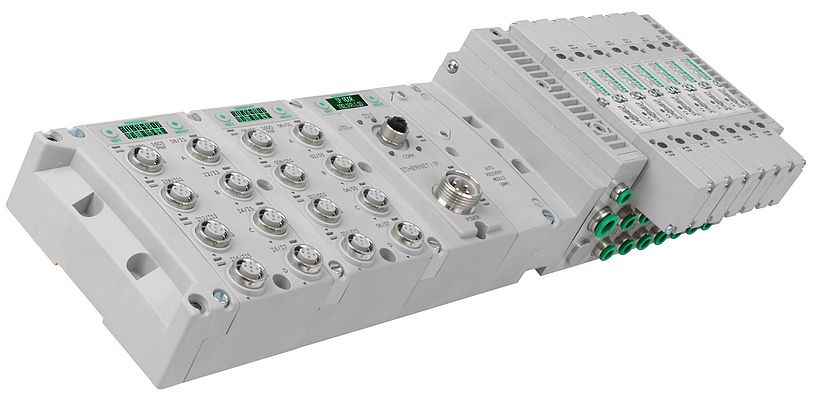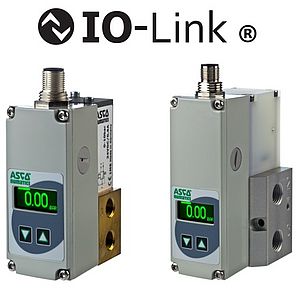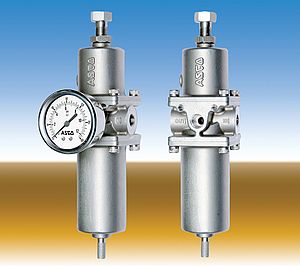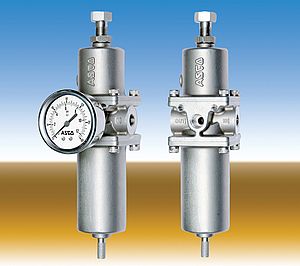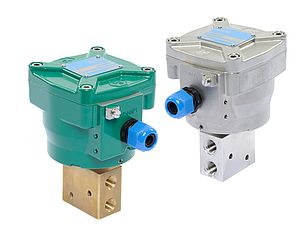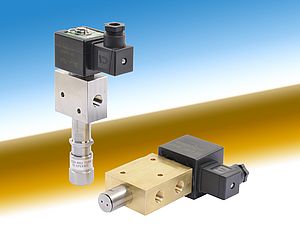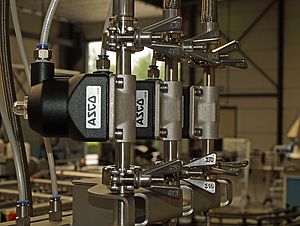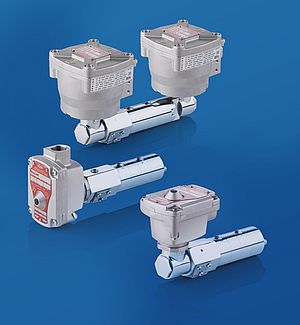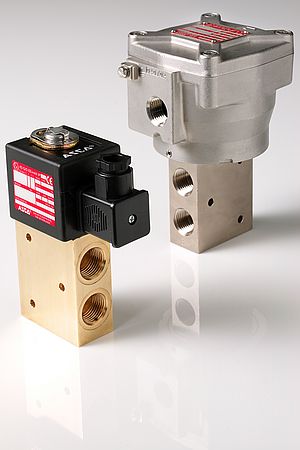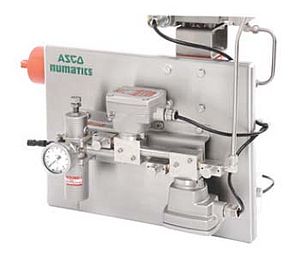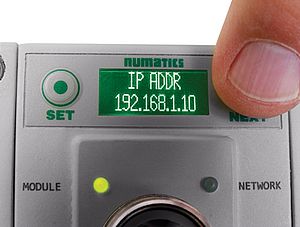Pneumatic fieldbus valve manifolds have a number of advantages over traditional hardwired solutions and the latest designs offer substantial improvements in the area of application, performance, and maintenance. In this article we look at five of the critical factors that must be considered before selecting pneumatic fieldbus valve manifolds.
In today’s highly automated machines, fieldbus valve manifolds are replacing conventional hardwired solutions. They perform vital functions by integrating communication interfaces to pneumatic valve manifolds with input/output (I/O) capabilities. This allows programmable logic controllers (PLCs) to efficiently turn valves on and off and to channel I/O data from sensors, lights, relays, individual valves, or other I/O devices via various industrial networks. The resulting integrated control packages can also be optimised to allow diagnostic benefits not previously available.
However, there are five critical factors that must be considered before selecting pneumatic fieldbus valve manifolds.
Commissioning: save time by removing DIP switches
Following installation, fieldbus manifolds must be tested and commissioned. When many connections are involved, time and costs quickly add up and users need to look for opportunities to reduce these costs. Some manufacturers now offer SPEEDCON M12 connectors, which need only a half-turn to gain a secure connection, reducing commissioning costs. Furthermore well-spaced I/O layouts can minimise the time needed to connect all necessary cables.
Configuration can be tedious with the prime reason being the dreaded DIP switch. Manipulating these tiny switches is an exercise in frustration. The user must constantly consult cryptic instructions in unfriendly user manuals to identify each switch’s function and settings. Visual feedback is limited to subtle positioning of the switch itself.
A recent innovation is the introduction of pneumatic fieldbus valve manifolds that embed a small graphic display on each module. This offers plain-language messaging that clearly identifies network addresses, baud rates, and other parametric data. Pushbuttons enable navigation through intuitive menus and users receive instant visual feedback of set values with error proof selections.
Distribution: flexibility enables savings
Historically, pneumatic fieldbus valve manifolds with integrated I/O modules have been designed within a relatively rigid architecture. So the OEM engineer would specify different modules for each task, together with multiple dedicated communication nodes on the machine’s industrial network.
However, newer designs offer more flexible, more cost-effective architectures. These provide fieldbus nodes that can handle both valves and I/O, as well as the mutual distribution of I/O and valve manifold functionality, thereby optimising the physical layout of the machine.
These new systems take advantage of sub-bus technology that allows the same modules that traditionally were part of a centralised manifold to be detached and used in a distributed architecture. Since sub-bus modules don’t show up as network nodes, the need for multiple PLC scanner cards is eliminated, while still allowing substantial I/O capacity. On industrial Ethernet applications, this architecture enables a reduction in the number of Ethernet switches and communication nodes
Modularity: allows easy assembly
Traditional fieldbus valve manifolds suffer from a fairly low degree of modularity. If an I/O module is malfunctioning or an alteration is required, conventional non-modular designs force the user to dismantle the entire assembly, dismount the offending module, replace it, and then reassemble.
Some new fieldbus manifold systems offer modular designs that simply connect together via removable clips and screws. This allows easy assembly and last-minute changes. Short I/O cables can be accommodated by simply unclipping the I/O module from the main pneumatic fieldbus valve manifold, and positioning it on the machine within reach of the cables, and connecting back to the main module via a sub-bus cable, without disrupting the I/O mapping.
Diagnostics: easy to use graphic displays
Today, most fieldbus manifolds allow diagnostic data to be signalled to a human/machine interface (HMI), often located away from the problem area. This option requires programming at set-up, and is considered too expensive. Another option allows the pneumatic fieldbus valve manifold to interface with a proprietary handheld HMI device. This represents an extra expense and requires. Many offer diagnostic LEDs on the manifold system itself, right at the point of use. Yet, many users carry painful memories of consulting cryptic instruction manuals while peering past tangled coils of cables and connectors at small LEDs.
New designs offer more functional alternatives. A module with integrated graphic display and plain-language messaging provides users and OEMs with point-of-use status and diagnostic information, plus set-up and version tracking data at the I/O-module and communication-node levels.
This arrangement places visual status and alarm indication away from tangled cables, in a clearly visible display area at one end of each module. It involves no programming or extra cost, and takes no training to use. Error messages are generated and cleared automatically, and blink to draw the eye immediately to the problem module. The associated pushbuttons allow the user to navigate quickly through intuitive menus for effective troubleshooting. Some systems even log errors for future or remote analysis.
Recovery: automatic and transparent
A final topic closely related to diagnostics is recovery. In a conventional pneumatic fieldbus valve manifold, this is usually difficult and time-consuming. Having isolated the faulty module, the entire system must be disassembled and DIP switch settings noted to enable the replacement part to operate properly. In effect, the new part must be commissioned from scratch, reloading all configuration settings before reassembly.
The latest advancements in fieldbus valve manifold designs provide a much better solution by including an auto-recovery module option. During a critical failure, this module stores and protects all commissioning or configuration parameters originally input. When a new communication or I/O module has been clipped into place, this device recognises it as a replacement unit and reloads all settings, configuration parameters, and other pertinent information into it. The technology works automatically and transparently, without user interaction.
Conclusion
Choosing the best pneumatic fieldbus valve manifold for a given automated machine application presents several challenges. Of special concern are the problems that many conventional pneumatic fieldbus valve manifolds exhibit in the areas of commissioning, distribution, modularity, diagnostics, and recovery. Control engineers, specifiers and buyers should consider newly available designs that apply proven technology in innovatively simple ways to resolve these problems. Users report that these solutions are delivering greater cost efficiency and wider application opportunities, while considerably improving commissioning, use, and maintenance.
Modular valve island
The modular ASCO Numatics G3 valve island with graphic display is easy to assemble, install, commission and maintain. It serves as an electronics platform for fieldbus applications. The G3 helps address commissioning and diagnostic concerns by banishing the dreaded DIP switch and the ineffective status LED. Instead, these systems integrate a plain-language graphic display on every module, with accessible pushbuttons and intuitive menus for easy configuration, status checking, and point-of-use diagnostics.
Installation is easy with half-turn SPEEDCON connectors enabling fast cable connections. G3 valve islands replace rigid architectures with a wide range of flexible – and cost-effective – I/O distribution possibilities, making the same components available for either centralised (main manifold) or distributed (sub-bus manifold) use.
The G3 supports up to 256/544 inputs/outputs with one communication node of up to 32 valve solenoids per manifold and up to 16 manifolds per communication node. The G3 interfaces to valves controlling flow rates from 275 to 3820l/min ANR. Communication protocols supported include DeviceNet, DeviceNet w/Quick Connect, EtherNet/IP, PROFIBUS-DP, CANopen, PROFINET, MODBUS/TCP, DeviceLogix and Powerlink
Fieldbus valve manifolds
- critical factors when selecting
- by Emerson Automation Solutions Div Fluid Control-Pneumatics
- February 27, 2012
- 628 views


